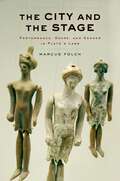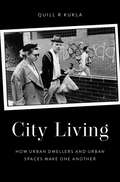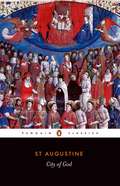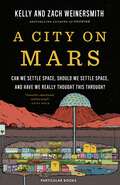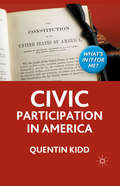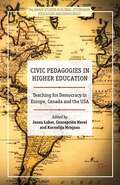- Table View
- List View
The City and the Stage: Performance, Genre, and Gender in Plato's Laws
by Marcus FolchWhat role did poetry, music, song, and dance play in the social and political life of the ancient Greek city? How did philosophy respond to, position itself against, and articulate its own ambitions in relation to the poetic tradition? How did ancient philosophers theorize and envision alternatives to fourth-century Athenian democracy? The City and the Stage poses such questions in a study of the Laws, Plato's last, longest, and unfinished philosophical dialogue. Reading the Laws in its literary, historical, and philosophical contexts, this book offers a new interpretation of Plato's final dialogue with the Greek poetic tradition and an exploration of the dialectic between philosophy and mimetic art. Although Plato is often thought hostile to poetry and famously banishes mimetic art from the ideal city of the Republic, The City and the Stage shows that in his final work Plato made a striking about-face, proposing to rehabilitate Athenian performance culture and envisaging a city, Magnesia, in which poetry, music, song, and dance are instrumental in the cultivation of philosophical virtues. Plato's views of the performative properties of music, dance, and poetic language, and the psychological underpinnings of aesthetic experience receive systematic treatment in this book for the first time. The social role of literary criticism, the power of genres to influence a society and lead to specific kinds of constitutions, performance as a mechanism of gender construction, and the position of women in ancient Greek performance culture are central themes throughout this study. A wide-ranging examination of ancient Greek philosophy and fourth-century intellectual culture, The City and the Stage will be of significance to anyone interested in ancient Greek literature, performance, and Platonic philosophy in its historical contexts.
City for Conquest
by Aben KandelF. Scott Fitzgerald's The Great Gatsby still captivates readers with its vision of 1920s New York as a city of infinite potential, where ambition and defeat live hand in hand. This sentiment is captured, with even greater acuity, in the pages of Aben Kandel's nearly forgotten masterpiece of urban life, City for Conquest (1936). The source of the classic 1940s James Cagney film of the same name, this panoramic New York novel captures the complex patterns of city life, vividly evoking a metropolis of dreams and nightmares.Kandel portrays a volatile city inhabited by the aristocrat, the criminal, the idealist, the bohemian, the driven, the entrapped, and the impoverished, all equally striving "to make a dent in this town." The city itself is booming, its new constructions callously built on destruction, supplanting with equal disdain the slums of Brooklyn and the farm fields of the Bronx. This feverish microcosm of humanity inhabits a world of immense inequality where "six blocks from Wall Street, people haven't got a dime, six blocks from duplex apartments, people live in hovels" and "between the scarlet sore and the apple of the eye there lay a thick eyebrow of indifference."A literary triumph in the tradition of Stephen Crane's Maggie: A Girl of the Streets and John Dos Passos' Manhattan Transfer, and out of print for far too long, City for Conquest is the inaugural work of fiction in Transaction's new Lost Urban Classics series.
City for Conquest (Lost Urban Classics Ser.)
by Aben KandelF. Scott Fitzgerald's The Great Gatsby still captivates readers with its vision of 1920s New York as a city of infinite potential, where ambition and defeat live hand in hand. This sentiment is captured, with even greater acuity, in the pages of Aben Kandel's nearly forgotten masterpiece of urban life, City for Conquest (1936). The source of the classic 1940s James Cagney film of the same name, this panoramic New York novel captures the complex patterns of city life, vividly evoking a metropolis of dreams and nightmares.Kandel portrays a volatile city inhabited by the aristocrat, the criminal, the idealist, the bohemian, the driven, the entrapped, and the impoverished, all equally striving "to make a dent in this town." The city itself is booming, its new constructions callously built on destruction, supplanting with equal disdain the slums of Brooklyn and the farm fields of the Bronx. This feverish microcosm of humanity inhabits a world of immense inequality where "six blocks from Wall Street, people haven't got a dime, six blocks from duplex apartments, people live in hovels" and "between the scarlet sore and the apple of the eye there lay a thick eyebrow of indifference."A literary triumph in the tradition of Stephen Crane's Maggie: A Girl of the Streets and John Dos Passos' Manhattan Transfer, and out of print for far too long, City for Conquest is the inaugural work of fiction in Transaction's new Lost Urban Classics series.
City Living: How Urban Spaces and Urban Dwellers Make One Another
by Quill R KuklaCity Living is about urban spaces, urban dwellers, and how these spaces and people make, shape, and change one another. More people live in cities than ever before: more than 50% of the earth's people are urban dwellers. As downtown cores gentrify and globalize, they are becoming more diverse than ever, along lines of race, ethnicity, socioeconomic class, sexuality, and age. Meanwhile, we are in the early stages of what seems sure to be a period of intense civil unrest. During such periods, cities generally become the primary sites where tensions and resistance are concentrated, negotiated, and performed. For all of these reasons, understanding cities and contemporary city living is pressing and exciting from almost any disciplinary and political perspective. Quill R Kukla offers the first systematic philosophical investigation of the nature of city life and city dwellers. The book draws on empirical and ethnographic work in geography, anthropology, urban planning, and several other disciplines in order to explore the impact that cities have on their dwellers and that dwellers have on their cities. It begins with a philosophical exploration of spatially embodied agency and of the specific forms of agency and spatiality that are distinctive of urban life. It explores how gentrification is enacted and experienced at the level of embodied agency, arguing that gentrifying spaces are contested territories that shape and are shaped by their dwellers. The book then moves to an exploration of repurposed cities, which are cities materially designed to support one sociopolitical order, but in which that order collapsed, leaving new dwellers to use the space in new ways. Through detailed original ethnography of the repurposed cities of Berlin and Johannesburg, Kukla makes the case that in repurposed cities, we can see vividly how material spaces shape and constrain the agency and experience of dwellers, while dwellers creatively shape the spaces they inhabit in accordance with their needs. The book concludes with a reconsideration of the right to the city, asking what would be involved in creating a city that enabled the agency and flourishing of all its diverse inhabitants.
City Living: How Urban Spaces and Urban Dwellers Make One Another
by Quill R KuklaCity Living is about urban spaces, urban dwellers, and how these spaces and people make, shape, and change one another. More people live in cities than ever before: more than 50% of the earth's people are urban dwellers. As downtown cores gentrify and globalize, they are becoming more diverse than ever, along lines of race, ethnicity, socioeconomic class, sexuality, and age. Meanwhile, we are in the early stages of what seems sure to be a period of intense civil unrest. During such periods, cities generally become the primary sites where tensions and resistance are concentrated, negotiated, and performed. For all of these reasons, understanding cities and contemporary city living is pressing and exciting from almost any disciplinary and political perspective. Quill R Kukla offers the first systematic philosophical investigation of the nature of city life and city dwellers. The book draws on empirical and ethnographic work in geography, anthropology, urban planning, and several other disciplines in order to explore the impact that cities have on their dwellers and that dwellers have on their cities. It begins with a philosophical exploration of spatially embodied agency and of the specific forms of agency and spatiality that are distinctive of urban life. It explores how gentrification is enacted and experienced at the level of embodied agency, arguing that gentrifying spaces are contested territories that shape and are shaped by their dwellers. The book then moves to an exploration of repurposed cities, which are cities materially designed to support one sociopolitical order, but in which that order collapsed, leaving new dwellers to use the space in new ways. Through detailed original ethnography of the repurposed cities of Berlin and Johannesburg, Kukla makes the case that in repurposed cities, we can see vividly how material spaces shape and constrain the agency and experience of dwellers, while dwellers creatively shape the spaces they inhabit in accordance with their needs. The book concludes with a reconsideration of the right to the city, asking what would be involved in creating a city that enabled the agency and flourishing of all its diverse inhabitants.
City of Equals
by Prof Jonathan Wolff Prof Avner de ShalitWhen we think about equality in the city, we are very likely to think first of the wide and growing divide between rich and poor, in material terms. Yet when we think more about a 'city of equals' it becomes apparent that how people feel treated by the city and those around them, and whether they can live according to their values, are much more central. Accordingly, combining their own reflections, a multi-disciplinary literature review, and, distinctively, more than 180 interviews in 10 cities in 6 countries, Wolff and de Shalit have derived an account of a city of equals based on the idea that it should give each of its city-zens a secure sense of place or belonging. Four underlying values structure this account. First, access to the goods and services of the city should not be based purely on the market. Second, each person should be able to live a life they find meaningful. Third, there should be diversity and wide social mixing. Fourth, there should be 'non-deferential inclusion': each person should be able to get access to what they are entitled to without being treated as less worthy than others. They should be able to enjoy their rights without bowing and scraping, waiting longer than others, or going through special bureaucratic hurdles. In sum, in a city of equals each person is proud of their city and has the (justified) feeling that their city is proud of (people like) them. This is an open access title available under the terms of a [CC BY-NC-ND 4.0 International] licence. It is free to read at Oxford Scholarship Online and offered as a free PDF download from OUP and selected open access locations.
City of Equals
by Jonathan Wolff Avner de ShalitWhen we think about equality in the city, we are very likely to think first of the wide and growing divide between rich and poor, in material terms. Yet when we think more about a 'city of equals' it becomes apparent that how people feel treated by the city and those around them, and whether they can live according to their values, are much more central. Accordingly, combining their own reflections, a multi-disciplinary literature review, and, distinctively, more than 180 interviews in 10 cities in 6 countries, Wolff and de Shalit have derived an account of a city of equals based on the idea that it should give each of its city-zens a secure sense of place or belonging. Four underlying values structure this account. First, access to the goods and services of the city should not be based purely on the market. Second, each person should be able to live a life they find meaningful. Third, there should be diversity and wide social mixing. Fourth, there should be 'non-deferential inclusion': each person should be able to get access to what they are entitled to without being treated as less worthy than others. They should be able to enjoy their rights without bowing and scraping, waiting longer than others, or going through special bureaucratic hurdles. In sum, in a city of equals each person is proud of their city and has the (justified) feeling that their city is proud of (people like) them. This is an open access title available under the terms of a [CC BY-NC-ND 4.0 International] licence. It is free to read at Oxford Scholarship Online and offered as a free PDF download from OUP and selected open access locations.
City of God
by Saint Augustine G. R. EvansSt Augustine, bishop of Hippo, was one of the central figures in the history of Christianity, and City of God is one of his greatest theological works. Written as an eloquent defence of the faith at a time when the Roman Empire was on the brink of collapse, it examines the ancient pagan religions of Rome, the arguments of the Greek philosophers and the revelations of the Bible. Pointing the way forward to a citizenship that transcends the best political experiences of the world and offers citizenship that will last for eternity, City of God is one of the most influential documents in the development of Christianity.
A City of Heretics: François Laruelle's Non-Philosophy and its variants (Angelaki: New Work in the Theoretical Humanities)
by Anthony Paul SmithFrançois Laruelle has been developing his project of non-philosophy since the 1970s. Throughout this time he has aimed at nothing less than the discovery and development of a new form of thinking that draws its material from philosophy and related disciplines, but uses them in inventive new ways that are seen as heretical by standard philosophical approaches. The contributions to this volume highlight Laruelle’s own distinctive approach to the history of thought and bring together researchers in the Anglophone and Francophone world who have taken up the project of non-philosophy in their own way, developing new heresies, sometimes even in relation to non-philosophy itself. The contributions here show the scope of non-philosophy with essays on gender, science, religion, politics, animals, and the history of philosophy. They are all brought together, not in a city of intellectuals bound together by law, but within a city of heretics bound together only by their status as stranger. This book was originally published as a special issue of Angelaki.
A City of Heretics: François Laruelle's Non-Philosophy and its variants (Angelaki: New Work in the Theoretical Humanities)
by Anthony Paul SmithFrançois Laruelle has been developing his project of non-philosophy since the 1970s. Throughout this time he has aimed at nothing less than the discovery and development of a new form of thinking that draws its material from philosophy and related disciplines, but uses them in inventive new ways that are seen as heretical by standard philosophical approaches. The contributions to this volume highlight Laruelle’s own distinctive approach to the history of thought and bring together researchers in the Anglophone and Francophone world who have taken up the project of non-philosophy in their own way, developing new heresies, sometimes even in relation to non-philosophy itself. The contributions here show the scope of non-philosophy with essays on gender, science, religion, politics, animals, and the history of philosophy. They are all brought together, not in a city of intellectuals bound together by law, but within a city of heretics bound together only by their status as stranger. This book was originally published as a special issue of Angelaki.
City of the Good: Nature, Religion, and the Ancient Search for What Is Right
by Michael Mayerfield BellHow we came to seek absolute good in religion and nature—and why that quest often leads us astrayPeople have long looked to nature and the divine as paths to the good. In this panoramic meditation on the harmonious life, Michael Mayerfeld Bell traces how these two paths came to be seen as separate from human ways, and how many of today’s conflicts can be traced back thousands of years to this ancient divide.Taking readers on a spellbinding journey through history and across the globe, Bell begins with the pagan view, which sees nature and the divine as entangled with the human—and not necessarily good. But the emergence of urban societies gave rise to new moral concerns about the political character of human life. Wealth and inequality grew, and urban people sought to justify their passions. In the face of such concerns, nature and the divine came to be partitioned from the human, and therefore seen to be good—but they also became absolute and divisive.Bell charts the unfolding of this new moral imagination in the rise of Buddhism, Christianity, Daoism, Hinduism, Jainism, and many other traditions that emerged with bourgeois life. He follows developments in moral thought, from the religions of the ancient Sumerians, Greeks, and Hebrews to the science and environmentalism of today, along the way visiting with contemporary indigenous people in South Africa, Costa Rica, and the United States. City of the Good urges us to embrace the plurality of our traditions—from the pagan to the bourgeois—and to guard against absolutism and remain open to difference and its endless creativity.
City of the Good: Nature, Religion, and the Ancient Search for What Is Right
by Michael Mayerfield BellHow we came to seek absolute good in religion and nature—and why that quest often leads us astrayPeople have long looked to nature and the divine as paths to the good. In this panoramic meditation on the harmonious life, Michael Mayerfeld Bell traces how these two paths came to be seen as separate from human ways, and how many of today’s conflicts can be traced back thousands of years to this ancient divide.Taking readers on a spellbinding journey through history and across the globe, Bell begins with the pagan view, which sees nature and the divine as entangled with the human—and not necessarily good. But the emergence of urban societies gave rise to new moral concerns about the political character of human life. Wealth and inequality grew, and urban people sought to justify their passions. In the face of such concerns, nature and the divine came to be partitioned from the human, and therefore seen to be good—but they also became absolute and divisive.Bell charts the unfolding of this new moral imagination in the rise of Buddhism, Christianity, Daoism, Hinduism, Jainism, and many other traditions that emerged with bourgeois life. He follows developments in moral thought, from the religions of the ancient Sumerians, Greeks, and Hebrews to the science and environmentalism of today, along the way visiting with contemporary indigenous people in South Africa, Costa Rica, and the United States. City of the Good urges us to embrace the plurality of our traditions—from the pagan to the bourgeois—and to guard against absolutism and remain open to difference and its endless creativity.
City on a Hill: A History of American Exceptionalism
by Abram C. Van EngenA fresh, original history of America’s national narratives, told through the loss, recovery, and rise of one influential Puritan sermon from 1630 to the present day In this illuminating book, Abram Van Engen shows how the phrase "City on a Hill," from a 1630 sermon by Massachusetts Bay governor John Winthrop, shaped the story of American exceptionalism in the twentieth century. By tracing the history of Winthrop’s speech, its changing status throughout time, and its use in modern politics, Van Engen asks us to reevaluate our national narratives. He tells the story of curators, librarians, collectors, archivists, antiquarians, and often anonymous figures who emphasized the role of the Pilgrims and Puritans in American history, paving the way for the saving and sanctifying of a single sermon. This sermon’s rags-to-riches rise reveals the way national stories take shape and shows us how those tales continue to influence competing visions of the country—the many different meanings of America that emerge from its literary past.
A City on Mars: Can We Settle Space, Should We Settle Space, and Have We Really Thought This Through?
by Dr. Kelly Weinersmith Zach WeinersmithONE OF THE TIMES BEST SCIENCE BOOKS OF THE YEARTHE INTERNATIONAL BESTSELLERFrom the bestselling authors of Soonish, a brilliant and hilarious off-world investigation into space settlementEarth is not well. The promise of starting life anew somewhere far, far away - no climate change, no war, no Twitter - beckons, and settling the stars finally seems within our grasp. Or is it? Bestselling authors Kelly and Zach Weinersmith set out to write the essential guide to a glorious future of space settlements, but after years of original research, and interviews with leading space scientists, engineers and legal experts, they aren't so sure it's a good idea. Space tech and space business are progressing fast, but we lack the deep knowledge needed to have space-kids, build space-farms and create space nations in a way that doesn't spark conflict back home. In a world hurtling toward human expansion into space, A City on Mars investigates whether the dream of new worlds won't create a nightmare, both for settlers and the people they leave behind.With deep expertise, a winning sense of humour and art from the beloved creator of Saturday Morning Breakfast Cereal, the Weinersmiths investigate perhaps the biggest questions humanity will ever ask itself - whether and how to become multiplanetary.
Civic Aesthetics: Militarism, Israeli Art and Visual Culture (Radical Aesthetics-Radical Art)
by Noa RoeiAwarded an Honourable Mention by the Association for Israeli Studies. Exploring the politics of the image in the context of Israeli militarized visual culture, Civic Aesthetics examines both the omnipresence of militarism in Israeli culture and society and the way in which this omnipresence is articulated, enhanced, and contested within local contemporary visual art. Looking at a range of contemporary artworks through the lens of “civilian militarism”, Roei employs the theory of various fields, including memory studies, gender studies, landscape theory, and aesthetics, to explore the potential of visual art to communicate military excesses to its viewers. This study builds on the specific sociological concerns of the chosen cases to discuss the complexities of visuality, the visible and non-visible, arguing for art's capacity to expose the scopic regimes that construct their visibility. Images and artworks are often read either out of context, on purely aesthetic or art-historical ground, or as cultural artefacts whose aesthetics play a minor role in their significance. This book breaks with both traditions as it approaches all art, both high and popular art, as part of the surrounding visual culture in which it is created and presented. This approach allows a new theory of the image to come forth, where the relation between the political and the aesthetic is one of exchange, rather than exclusion.
Civic Aesthetics: Militarism, Israeli Art and Visual Culture (Radical Aesthetics-Radical Art)
by Noa RoeiAwarded an Honourable Mention by the Association for Israeli Studies. Exploring the politics of the image in the context of Israeli militarized visual culture, Civic Aesthetics examines both the omnipresence of militarism in Israeli culture and society and the way in which this omnipresence is articulated, enhanced, and contested within local contemporary visual art. Looking at a range of contemporary artworks through the lens of “civilian militarism”, Roei employs the theory of various fields, including memory studies, gender studies, landscape theory, and aesthetics, to explore the potential of visual art to communicate military excesses to its viewers. This study builds on the specific sociological concerns of the chosen cases to discuss the complexities of visuality, the visible and non-visible, arguing for art's capacity to expose the scopic regimes that construct their visibility. Images and artworks are often read either out of context, on purely aesthetic or art-historical ground, or as cultural artefacts whose aesthetics play a minor role in their significance. This book breaks with both traditions as it approaches all art, both high and popular art, as part of the surrounding visual culture in which it is created and presented. This approach allows a new theory of the image to come forth, where the relation between the political and the aesthetic is one of exchange, rather than exclusion.
Civic and Moral Learning in America
by D. Warren J. PatrickFrom its formative years to the present, advocates of various persuasions have written and spoken about the country's need for moral and civic education. Responding in part to challenges posed by B. Edward McClellan, this book offers research findings on the ideas, people, and contexts that have influenced the acquisition of moral and civic learning in the America.
Civic and Uncivic Values in the Czech Republic: Value Transformation, Politics, Education, and Gender Equality
by Sabrina P. Ramet Vladimir Ðorđević Christine M. HassenstabThis book considers the state of Czech democracy, following the rise of authoritarian regimes in Poland and Hungary and the ascent of billionaire oligarch Andrej Babiš to the office of prime minister of the Czech Republic, leading to concerns about conflict of interest. The authors argue that civic values, such as tolerance, respect for the equality of people, and readiness to play by the rules of the political game, are key factors in determining whether the Czech Republic will maintain its democracy in the coming years. The book employs a broad perspective, bringing together insights from political science, sociology, cultural studies, and other disciplines to analyse changes in the democracy of the Czech Republic since 1989, taking into consideration various dimensions of civic values, including politics, gender inequality, film, and the media.
The Civic Bargain: How Democracy Survives
by Brook Manville Josiah OberA powerful case for democracy and how it can adapt and survive—if we want it toIs democracy in trouble, perhaps even dying? Pundits say so, and polls show that most Americans believe that their country’s system of governance is being “tested” or is “under attack.” But is the future of democracy necessarily so dire? In The Civic Bargain, Brook Manville and Josiah Ober push back against the prevailing pessimism about the fate of democracy around the world. Instead of an epitaph for democracy, they offer a guide for democratic renewal, calling on citizens to recommit to a “civic bargain” with one another to guarantee civic rights of freedom, equality, and dignity. That bargain also requires them to fulfill the duties of democratic citizenship: governing themselves with no “boss” except one another, embracing compromise, treating each other as civic friends, and investing in civic education for each rising generation.Manville and Ober trace the long progression toward self-government through four key moments in democracy’s history: Classical Athens, Republican Rome, Great Britain’s constitutional monarchy, and America’s founding. Comparing what worked and what failed in each case, they draw out lessons for how modern democracies can survive and thrive. Manville and Ober show that democracy isn’t about getting everything we want; it’s about agreeing on a shared framework for pursuing our often conflicting aims. Crucially, citizens need to be able to compromise, and must not treat one another as political enemies. And we must accept imperfection; democracy is never finished but evolves and renews itself continually. As long as the civic bargain is maintained—through deliberation, bargaining, and compromise—democracy will live.
Civic Continuities in an Age of Revolutionary Change, c.1750–1850: Europe and the Americas (Palgrave Studies in Political History)
by Judith Pollmann Henk Te VeldeThis open access book explores the role of continuity in political processes and practices during the Age of Revolutions. It argues that the changes that took place in the years around 1800 were enabled by different types of continuities across Europe and in the Americas. With historians of modernity tending to emphasise the rise of the new, scholarship has leaned towards an assumption that existing modes of action, thought and practice simply became extinct, irrelevant or at least subordinate to new modes. In contrast, this collection examines continuities between early modern and modern political cultures and organization in Europe and the Americas. Shifting the focus from political modernization, the authors examine the continued relevance of older, often local, practices in (post)revolutionary politics. By doing so, they aim to highlight the role of local political traditions and practices in forging and enabling political change. The book argues that while political change was in fact at the centre of both the old and new polities that emerged in the Age of Revolutions, it coexisted with, and was indeed enabled by, continuities at other levels.
Civic Education and Liberal Democracy: Making Post-Normative Citizens in Normative Political Spaces
by Peter StrandbrinkThis book explores the inherent tension in civic education. There is a surging belief in contemporary European society that liberal democracy should work harder to reproduce the civic and normative setups of national populations through public education. The cardinal notion is that education remains the best means to accomplish this end, and educational regimes appropriate tools to make the young more tolerant, civic, democratic, communal, cosmopolitan, and prone to engaged activism. This book is concerned with the ambiguities that strain standard visions of civic education and educational statehood. On the one hand, civic-normative education is expected to drive tolerance in the face of conflicting good-life affirmations and accelerating worldview pluralisation; on the other hand, nation-states are primarily interested in reproducing the normative prerogatives that prevail in restricted cultural environments. This means that civic education unfolds on two irreconcilable planes at once: one cosmopolitan/tolerant, another parochial/intolerant. The book will be of significant interest to students and scholars of education, sociology, normative statehood, democracy, and liberal political culture, particularly those working in the areas of civic education; as well as education policy-makers.
Civic Education and Liberal Democracy: Making Post-Normative Citizens in Normative Political Spaces (pdf)
by Peter StrandbrinkThis book explores the inherent tension in civic education. There is a surging belief in contemporary European society that liberal democracy should work harder to reproduce the civic and normative setups of national populations through public education. The cardinal notion is that education remains the best means to accomplish this end, and educational regimes appropriate tools to make the young more tolerant, civic, democratic, communal, cosmopolitan, and prone to engaged activism. This book is concerned with the ambiguities that strain standard visions of civic education and educational statehood. On the one hand, civic-normative education is expected to drive tolerance in the face of conflicting good-life affirmations and accelerating worldview pluralisation; on the other hand, nation-states are primarily interested in reproducing the normative prerogatives that prevail in restricted cultural environments. This means that civic education unfolds on two irreconcilable planes at once: one cosmopolitan/tolerant, another parochial/intolerant. The book will be of significant interest to students and scholars of education, sociology, normative statehood, democracy, and liberal political culture, particularly those working in the areas of civic education; as well as education policy-makers.
Civic Engagement and Community Service at Research Universities: Engaging Undergraduates for Social Justice, Social Change and Responsible Citizenship (Palgrave Studies in Global Citizenship Education and Democracy)
by Krista M. Soria Tania D. MitchellThis book outlines how undergraduate students engage with civic and community projects and how this can be encouraged by their universities. It also explores how universities can build on this involvement and develop undergraduates' civic and democratic capacities, including programmatic strategies and conceptual frameworks for understanding the students' activities. As higher education across the globe experiences increasing student numbers it is important to understand how students engage with civic and community service.
Civic Participation in America
by Q. KiddThis book argues that the declining nature of traditional forms of civic participation over the last half century are the result of the evolution of larger institutional, social, and historical forces that have favored the self-interest motivation at the expense of civic duty
Civic Pedagogies in Higher Education: Teaching for Democracy in Europe, Canada and the USA (Palgrave Studies in Global Citizenship Education and Democracy)
by Jason Laker Concepción Naval Kornelija MrnjausIn this book, university teachers provide case studies illustrating methods employed to prepare citizens for meaningful participation in democracies, whether long-standing, young or emerging. Examples of practice from Western Europe, Eastern Europe, and North America are included, along with reflections and advice for practice.
